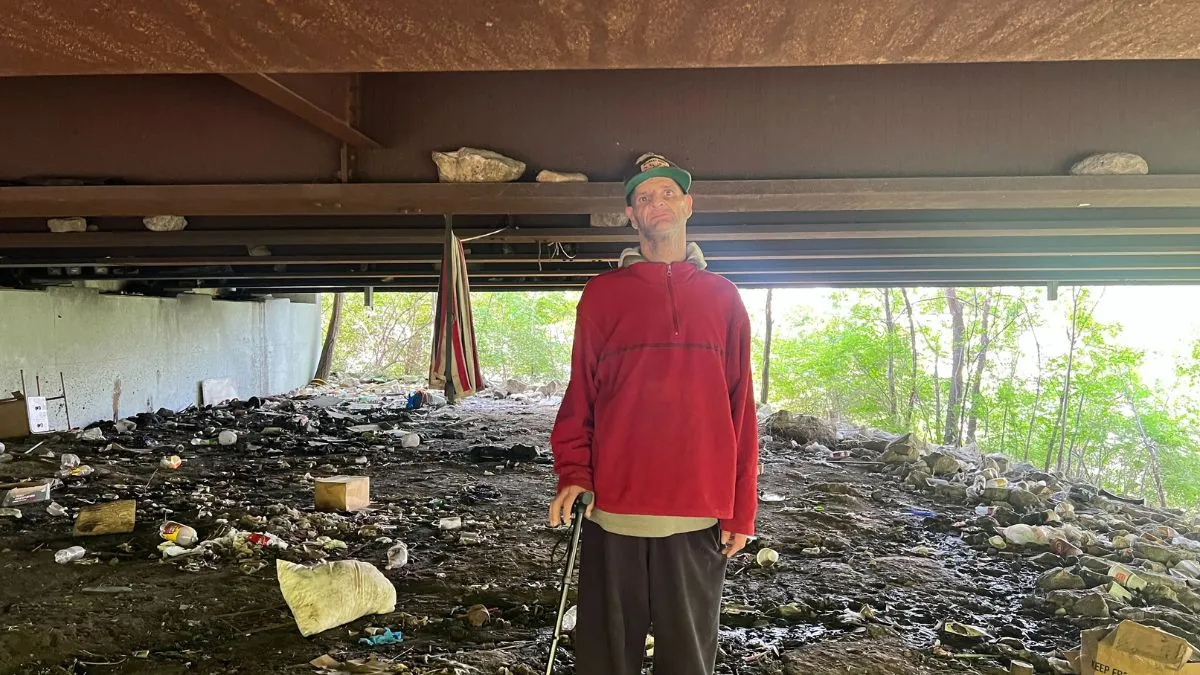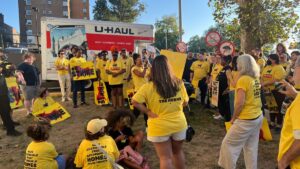10:40
News Story
Neighborhood blocks a low-barrier shelter some see as key to solving homelessness in KC
Kansas City has the highest rate of unsheltered people experiencing long-term homelessness in the country, with 96% living on the streets
Ken Simard mainly slept under the Blue Parkway bridge near railroad tracks along Brighton Avenue for the seven years he was homeless, numbing himself with meth and weed.
“If it were not for the drugs that I did, I would have been suicidal,” he said. “I would do anything to take my mind and put it in an alternate place and time.”
That drug use would have made him unwelcome at Kansas City’s homeless shelters.
“It’s not a good mix to have somebody who’s hallucinating with people who are sober or haven’t used,” he said. “When you’re hallucinating you’re inclined to think your best friend is out to get you. It just turns into a dangerous environment for all parties involved.”
Kansas City has the country’s highest rate of chronically homeless people who can’t find an apartment — or space in a shelter. A U.S. Department of Housing and Urban Development survey found that 96% of those people in Kansas City live on the street.
Last year, the Kansas City Council set out to pass along $7.1 million in federal tax dollars for a low-barrier shelter — a last-resort way to get people off the streets by dropping the usual shelter rules like sobriety or job skills training. It’s a key part of the city’s Zero KC plan to end homelessness by the end of the decade.
Hope Faith Homeless Assistance Campus landed a grant from the city in January to open a low-barrier shelter at Virginia Avenue and Admiral Boulevard.
But pushback from residents in Northeast neighborhoods stalled that plan. They’re worried about the safety of a center that they fear would concentrate people with mental health or substance abuse issues to one place. That opposition prompted the City Council to retract its grant to Hope Faith for a low-barrier shelter.
Factions in the Northeast neighborhood lobbied to split the money among multiple, scattered shelters.
But that money won’t stretch far enough for multiple shelters. So Hope Faith argues Kansas City needs at least one place that takes in people other shelters turn away — if it wants to make sure people aren’t forced to live under bridges or in encampments.
“If we don’t help them, then where do they go? The streets. And I’ve never seen anyone improve their life by living long-term on the streets,” said Hope Faith Executive Director Doug Langner. “The solution for this problem is to get them off the streets. And we feel we have a plan.”
Why did the City Council restart the low-barrier homeless shelter application?
The Kansas City Council voted 8-2 on April 25 to restart grant applications. Of the $7 million, $5 million will be set aside for the construction of a new shelter.
Evie Craig, president of the Paseo West Neighborhood Association, said the City Council should have been more transparent about what was planned and where it would go. She said residents weren’t aware there were plans to build a shelter in her neighborhood until after the proposal was approved.
“There was no community notification or engagement,” she said. “Why not share outcomes and issues and have regular meetings? It could be a true collaboration between providers and neighborhoods.”
Craig said large homeless shelters aren’t always safe for all populations, particularly queer people or victims of domestic abuse.
“One large building that the city is investing in can become an area where you have the same kind of dynamics that happens on the street,” she said. “Like a (homeless) campground in concrete. You really want a place where folks can feel safe.”
She said many Northeast residents don’t want their neighborhood to host the only low-barrier shelter in the city. Hope Faith is located near several other homeless services, such as reStart Inc., City Union Mission and NourishKC.
Craig said the neighborhood has supported those groups, but she doesn’t think converting Hope Faith into a shelter is an accessible plan for everyone in the metro. Residents would like to see the money distributed to other shelters across the city or establish new small-scale shelters.
“There are pockets of street homelessness throughout the city,” she said. “And we felt that one place where you’re displacing folks from where their support system is may not be the best solution. We’re advocating for a better solution. Not just the easiest one.”
But Josh Henges, the city’s homeless prevention coordinator, said the $7 million in federal money barely pays for a single shelter and couldn’t be used effectively for multiple locations.
“That argument is fine if we’re splitting up $100 million, but we’re not,” he said. “The quickest way to have 100 homeless people standing outside of your homeless shelter is to have a homeless shelter that only has 40 beds.”
Henges said that Kansas City can’t afford to wait for a perfect solution before taking action.
“We’re not even close to a solution. And we’re arguing about why we need multiple shelters,” he said. “So that means let’s not just start with one?”
Could splitting up the money work?
Henges said the city is making a mistake by trying to appease residents. He argues residents will always oppose a shelter in their neighborhood. So trying to win over residents, he said, means endless delays and abandoning the ambitious Zero KC goal of ending homelessness by 2030.
“There’s always going to be people who don’t want a thing,” Henges said. “If the role of (the City Council) is to appeal to the people who don’t want a thing, nothing is going to get done.”
Henges argued that low-barrier shelters are critical when he co-wrote the Zero KC plan. He said City Hall needs to listen to the insights of people working directly with the homeless community.
“Kansas City isn’t special,” Henges said. “It has to solve homelessness the way homelessness is solved everywhere and you have to have a starting point, which is a low-barrier emergency shelter.”
He said spreading money across existing shelters with stricter requirements won’t work. Rather, he sees a low-barrier shelter as the best chance to make a difference for the chronically homeless, who have experienced homelessness for at least a year — or repeatedly — while struggling with substance abuse, a serious mental illness or a physical disability.
“We’re trying to solve for chronic homelessness,” Henges said. “We have nothing for chronic homelessness, which is the reason the emails are coming in, the reason the cops get called and the reason that ERs are plugged up.”
He acknowledged Northeast residents’ concerns, but said Hope Faith has served the chronically homeless for a decade. He said a shelter there wouldn’t concentrate homelessness, but provide much-needed services to an existing population.
“They are a low-barrier day center,” he said. “What we’re trying to do is solve the problem of what happens when Hope Faith is closed (at night).”
Hope Faith’s application included a proposal to use the $5 million to expand its campus at Virginia Avenue and Admiral Boulevard by creating up to 100 beds with shared bathrooms.
But rules attached to the federal tax dollars call for individual rooms and private bathrooms. Langner said Hope Faith originally proposed shared bathrooms to maximize the bed count. In the new application, it will include more bathrooms but have to cut out 70 beds.
Kansas City spent four times as much on a single animal shelter, so Langner said $7 million is barely enough for a single homeless shelter.
“I can’t put our organization in a spot where we either can’t do construction, or have to do it in such a manner that’s not dignified,” he said. “If they split this pot of money up, then I don’t know that we could move forward.”
Why is low-barrier homeless shelter necessary in Kansas City?
National Alliance to End Homelessness says more than one in five people who become homeless end up that way chronically. A chronically homeless person costs taxpayers more than $35,000 a year. Give them housing, the group says, and that cost is cut in half.
Langner said he understands why residents are concerned about the safety of a large facility. A homeless person is more likely to be the victim of a crime than to commit one. And he said a larger low-barrier shelter doesn’t have to bring chaos.
If Hope Faith becomes a shelter, guests will not have to pray to stay or be sober, so long as they pose no danger to themselves and others, he said.
Bakersfield, California, ended chronic homelessness for a moment. In 2020, the county briefly achieved functional zero, meaning at least as many people escaped homelessness as fell into it.
Federal pandemic funding allowed homeless service agencies to place people in hotels and motels. But that wasn’t a long-term solution. The high cost of housing in California remains the core issue, said Carlos Baldovinos, chairman of the Bakersfield Kern Regional Homeless Collaborative in Bakersfield.
Baldovinos said communities will decide what best suits their low-barrier shelter needs through trial and error. Low-barrier shelters in Kern County, for example, began to allow guests to bring their pets. Some shelters even installed dog kennels.
He said large shelters should have evaluations and trained professionals on-site to deal with mental health issues or substance abuse.
“You have to accommodate people where they are and work with them,” he said. “Doing nothing is not an option.”
Henges said Kansas City needs to do something now if city leaders want to see Zero KC hit its 2030 goal. For now, he said, Kansas City is behind schedule.
“We are more likely to double our homeless population than we are to reduce the homeless population by even 5 percent,” he said. “At some point, your elected officials have to decide this is a problem they want to solve. Until then, it’s not solvable.”
This article first appeared on The Beacon and is republished here under a Creative Commons license.![]()
Our stories may be republished online or in print under Creative Commons license CC BY-NC-ND 4.0. We ask that you edit only for style or to shorten, provide proper attribution and link to our website. AP and Getty images may not be republished. Please see our republishing guidelines for use of any other photos and graphics.





